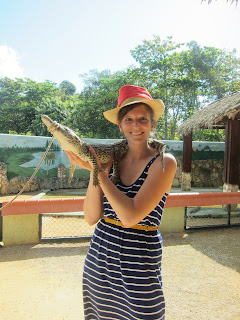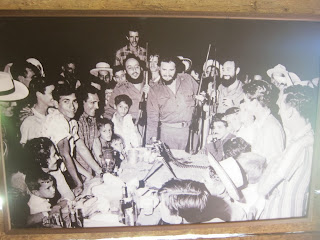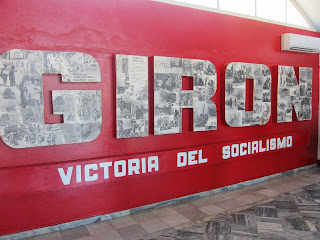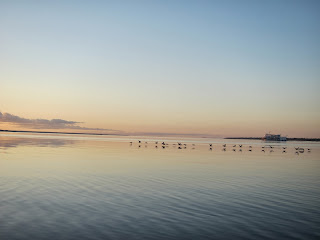We're back on land and in Charlottesville now, but I don't want to leave the blog incomplete so I'm going to finish it off with some Cuba wrap-ups. Cuba was a later addition to our trip, as we only received permission from the United States Treasury - Office of Asset Control (OFAC) right before the voyage began. OFAC controls trade with countries the US has sanctions against, like Cuba. Since a few year's after Castro's Revolution in 1959, there has been minimal to no trade with Cuba and US citizens are not allowed to travel there as tourists. Educational programs and people-to-people missions are occasionally allowed, and thus the M/V Explorer received permission to go. However, as we found out about a month before arrival, the license did not extend to faculty dependents (spouses and children), so Jason would not be able to go. Since they couldn't even be in Cuba waters, ISE created a backup plan to leave them at a resort in Freeport, Grand Bahama for 5 days. It wasn't Cuba, but Jason says it wasn't a bad plan B! That was our first experience with the strange world that is US-Cuba relations. The embargo was implemented 40+ years ago, only the US and Israel continue to support it, it doesn't seem to be doing much, and yet a 3 year old can't go to Cuba because...they might spend money?
Anyway, we dropped the kiddos and spouses off in the Bahamas and made our way to Havana. The night before we arrived I got an email from Mom with a picture of the family getting their Christmas tree in the snow. I was feeling sort of homesick until I woke up the next morning to this:
 |
| Entrance to Havana harbor at sunrise |
Inside the harbor we sailed along the Malecon, the wide boardwalk originally build to protect the city from the sea, but that now serves as a gathering ground for tourists and locals alike.
Because of Cuban (and US) economic policies, many of the buildings are very rundown and even those that look like they are about to collapse are inhabited. This one has laundry hanging out to dry in an upper window.
We approached our berth, where the water was reflecting the buildings beautifully. It's hard to tell in the small photo, but the flags hanging on the building to the left are the Cuban national flag and the flag of the FEU - Federacion Estudiantil Universitaria (Federation of University Students), a powerful student group in the country. They were responsible for organizing some of our stay in Cuba, in conjunction with the University of Havana.
Our berth was right near Habana Vieja (Old Havana). So close, in fact, that it startled me when I walked to the back deck of the ship. We were practically parked IN a building!
 |
| Oh hey there, Havana. |
We had to wait a bit for the ship to clear immigration and customs. Our entire first day was scheduled for us. All 700+ of us would be visiting the University of Havana for a series of events - welcomes, lectures, and cultural displays - before returning to the ship for a mandatory meeting with representatives of the US Interests Section.
When we did get off the ship, the first thing we saw were tons of posters in the cruise terminal about the Cuban 5. We saw their faces on signs everywhere around Havana - basically they are 5 Cuban spies who were caught and jailed in the US. Cuba (and others) claim they had an unfair trial and thus are demanding their release. The US (and the US Interest Section officer we met with) insist that the US system is fairer than anything in Cuba and if they are still imprisoned it must be because they were guilty. More info here:
http://en.wikipedia.org/wiki/Cuban_Five
The most amazing thing to me was that this is clearly a big deal in Cuba. I can't overestimate the number of posters we saw. And yet, none of us on the ship had ever heard of them. A real lesson in perspective.
We got on the buses and headed over to the University of Havana, just a few miles from where we were docked.
 |
| I liked this lady looking out her window. |
When we got there, there was a welcome speech and tons of journalists from all over the world. I got interviewed (in Spanish) by a Spanish news station, others were interviewed by reporters from Cuban, Chinese, and US news stations. I was asked what it was like being on the ship, what I thought of US-Cuba relations, and how it felt to be in Cuba, a place prohibited to most Americans.
 |
| My 15 seconds of fame. |
After a bit we climbed the steps to the University itself, a tradition for all students there. As we climbed John Lennon's "Imagine" played, bringing tears to a few people's eyes.
Inside the university courtyard there were more speeches by the rector and by our deans, followed by a series of lectures on science at the University of Havana, US-Cuban relations, and the Cuban political system. At the same time our students mingled with the Cuban students, and we ended the day with a cultural show and outdoor dance party. It was hot and sticky, but a lot of fun. The general message seemed to be that despite our political stances, we can - and should - all be friends.
 |
| There's the FEU sign again. |
After the US Interests Section presentation back on the ship, we were turned loose in Havana. I went out with a several of the other temporary singles (wives and husbands left in the Bahamas) to see if we could find some Cuban mojitos and maybe some live music.
 |
| Old Havana |
 |
| Old Havana |
We ended up at the Cafe Paris in Old Havana, located on Obispo Street where many of the restaurants and bars designed for tourists are located. Two Cubans told me they call Obispo the "calle prohibida" (forbidden street) because they can't afford to buy anything there. Cuba has a very complex system of two currencies - regular pesos for Cubans, and convertible pesos pegged to the dollar for tourists and for buying luxury items. Basically any place that charges in convertible pesos (CUCs) is too expensive for most Cubans. I still don't really understand how it all works, and it's starting to look like they
may eventually unify the two currencies.
Anyway, we found our mojitos.
 |
| Glass filled with mint lined up and ready to be doused in lime juice, rum, and sugar. |
And some live music.
 |
| The guy on the left is the professor I TA'd for on the ship. |
I spoke with the people in the band for a really long time. They were very very nice, as were all Cubans. Despite our governments' problems, I never felt any animosity towards me, an American. In fact, everyone wanted to talk, get to know me, and tell me about themselves. The lead singer of this band asked me if I might have any toiletries I could give them (
I guess soap is hard to come by in Cuba), so I made a point of gathering up all the mini-toiletries on the ship and dropping them off the next day.
 |
| Cathedral Square at night |
I had been asked to join a gathering of Cuban diplomates and representatives of the ship at 8pm, so I had to head back early for that. It turned out to be a very fun reception, so I am very glad I was invited. Then it was early to bed, as I was heading to Bay of Pigs in the morning and we had a 6:00 breakfast time!












































































